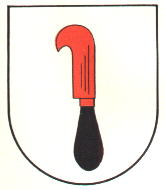Eisental: Difference between revisions
Jump to navigation
Jump to search
Knorrepoes (talk | contribs) No edit summary |
Knorrepoes (talk | contribs) m (Text replace - "'''Origin/meaning :'''<br/>" to "====Origin/meaning====") |
||
| Line 17: | Line 17: | ||
In Silber ein pfahlweis gestelltes rotes Winzermesser mit schwarzem Griff. | In Silber ein pfahlweis gestelltes rotes Winzermesser mit schwarzem Griff. | ||
====Origin/meaning==== | |||
Eisental became a separate municipality at the end of the 18<sup>th</sup> century. The oldest, 19<sup>th</sup> century seal shows already the knife (used for cutting grapes). Later seals showed the same image, which was approved as arms in April 1900. | Eisental became a separate municipality at the end of the 18<sup>th</sup> century. The oldest, 19<sup>th</sup> century seal shows already the knife (used for cutting grapes). Later seals showed the same image, which was approved as arms in April 1900. | ||
Revision as of 07:32, 1 April 2012
| Heraldry of the World Civic heraldry of Germany - Deutsche Wappen (Gemeindewappen/Kreiswappen) |
EISENTAL
State : Baden-Württemberg
District (Kreis) : Rastatt (until 1972 Bühl)
Incorporated into : 1972 Bühl
Official blason:
In Silber ein pfahlweis gestelltes rotes Winzermesser mit schwarzem Griff.
Origin/meaning
Eisental became a separate municipality at the end of the 18th century. The oldest, 19th century seal shows already the knife (used for cutting grapes). Later seals showed the same image, which was approved as arms in April 1900.
Literature : Zier, 1964.

